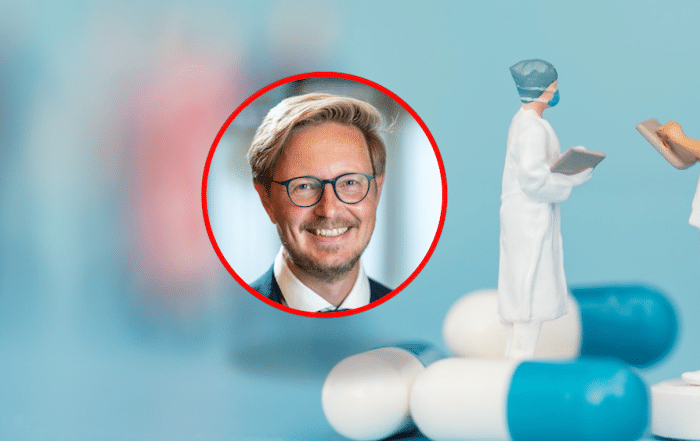Maurice van den Bosch (OLVG) over innovatie in de zorg
Digitale oplossingen, data science, AI-gedreven innovatie – het zijn dé topics binnen de ‘smart’ gezondheidszorg. Maar bij het grote publiek is er nog steeds een gebrek aan begrip en zijn patiënten bang dat AI het menselijke contact zal vervangen door een robot.
OLVG, het toonaangevende klinische ziekenhuis van Amsterdam, speelt een voortrekkersrol bij het toepassen van nieuwe tech- en digitale zorgoplossingen. CEO Maurice van den Bosch heeft als missie om vertrouwen op te bouwen en de voordelen van innovatie te delen met zoveel mogelijk mensen – zowel patiënten als collega’s in de gezondheidszorg.
Nieuwsgierigheid en creativiteit
Van den Bosch is ervan overtuigd dat data science en AI-innovaties de zorg toegankelijker maken en het welzijn en de kwaliteit van leven van mensen verbeteren. Volgens hem heeft de coronapandemie de noodzaak van een transformatie van de gezondheidszorg duidelijk gemaakt. Het heeft ook de ontwikkeling van digitale oplossingen versneld. En, zegt hij, dat is een van de redenen waarom hij het OLVG graag wilde leiden. “OLVG-medewerkers hebben nieuwsgierigheid in hun DNA”, zegt hij. “Veel van hen zijn ondernemer. Ze verzinnen dingen. Ik zou het woord creatief gebruiken. Het leiderschapsteam, de verpleegkundigen, de specialisten, ze proberen allen nieuwe oplossingen te vinden.”
Uit de comfortzone stappen
In 2019 ontwikkelden Van den Bosch en zijn team de ‘Close to you’-strategie, die gaat over “uit de eigen comfortzone stappen en een brug slaan naar de zorg voor patiënten thuis”. Als onderdeel van deze strategie heeft het ziekenhuis een nieuw platform voor elektronische medische dossiers geïntroduceerd. Van den Bosch omschrijft het als “een app-omgeving” waarvoor patiënten zich kunnen aanmelden als ze naar het ziekenhuis komen. Inmiddels gebruiken meer dan 200.000 mensen het systeem. Het stelt hen in staat om afspraken te maken, behandelingen in te plannen en de resultaten van diagnostische tests te delen.
Virtuele afdeling bouwen
Het tweede grote digitale programma van OLVG verbreedt deze focus op de relatie tussen ziekenhuis en patiënt en past deze toe op alle zorg binnen de regio Amsterdam. De Virtual Ward is een samenwerkingsverband tussen Cordaan, Zilveren Kruis en de Amsterdamse Huisartsen Alliantie. De Virtual Ward heeft als doel de zorg voor chronische patiënten buiten de ziekenhuisomgeving te verbeteren, zonder huisartsen en zorgverleners extra te belasten. Een digitaal platform en monitoringsysteem op afstand stellen huisartsen, hulpverleners en OLVG-medewerkers in staat samen te werken aan het adviseren van patiënten en het waarborgen van hun veiligheid.
Grote doorbraak voor patiënten
De ambitie is nu om de Virtual Ward op te schalen naar landelijk niveau. Van den Bosch is een drijvende kracht achter Santeon, een netwerk van zeven klinische medische centra in Nederland, gedreven door het principe van value-based healthcare. Dit jaar lanceerde Santeon het programma Santeon at Home, met als doel de Virtual Ward opnieuw in te richten voor gebruik door alle deelnemende medische centra. “Als we een gemeenschappelijke taal kunnen bedenken en gegevens kunnen delen die analyse en het bouwen van algoritmes mogelijk maken, zou dat dan geen grote doorbraak zijn voor patiënten?” Santeon at Home is in ontwikkeling en Van den Bosch hoopt eind dit jaar live te gaan.
Een hybride systeem
Niet iedereen is even positief over digitale innovatie in de zorg. Van den Bosch vindt het heel belangrijk om eventuele zorgen te adresseren over het verlies van face-to-face contact tussen patiënt en zorgverlener. Digitale oplossingen zijn nodig om de zorg toegankelijk te houden, zegt hij, maar vertrouwen moet worden opgebouwd in een hybride systeem. “We zullen nog steeds verpleegkundigen en artsen hebben in ziekenhuizen. Er zullen momenten zijn en er zijn ziektes waarbij je de verzorger wilt zien en elkaar in de ogen wilt kijken.”
Chronische ziekten ziet hij als ideale proeftuin voor nieuwe gezondheidszorgmodellen. Deze patiënten hebben over het algemeen een hoog kennisniveau over hun zelfzorg en zij leven met hun aandoening buiten een ziekenhuisomgeving. Tijdens de pandemie was zo’n 50% van de fysieke chronische zorgconsulten digitaal. En dat is nog steeds zo, want, zoals Van den Bosch opmerkt, dat is wat veel patiënten prefereren.
“We bespreken dit veel met collega’s, maar we moeten de stem van de patiënten inbrengen. Ze vragen om vriendelijke oplossingen. Het wordt steeds handiger als het digitaal kan.”
Druk om te leveren
Een recent artikel van ondernemersorganisatie VNO-NCW suggereerde dat een conservatieve medische sector innovatie in de weg staat. Van den Bosch vindt die kritiek onterecht. Hoewel hij het ermee eens is dat er meer verandering nodig is, wijst hij op de ongelooflijke belasting die het gezondheidszorgsysteem heeft gekend tijdens de coronapandemie. Hij is van mening dat verpleegkundigen en artsen zeer gemotiveerd zijn om de patiëntenzorg te verbeteren en bereid zijn hun manier van werken te veranderen. Maar in het licht van aanhoudende werkdruk en personeelstekorten is dat makkelijker gezegd dan gedaan. “Mensen staan al meer dan twee jaar onder enorme stress; we moeten rekening houden met de druk om te presteren binnen het bestaande systeem”, zegt hij, eraan toevoegend dat het gemakkelijk is om vanaf de zijlijn te vertellen wat mensen moeten doen. Het is belangrijk het systeem zelf te begrijpen en te snappen hoe verandering tot stand komt.
De ramen openen
Innovatie is volgens Van den Bosch niet af te dwingen. Nieuwe oplossingen worden vaak gevonden buiten de gevestigde systemen, maar verandering moet van binnenuit gebeuren. Van den Bosch heeft eerder gezegd dat “innovatie plaatsvindt als de ramen open staan”, en het is een bijzonder treffende metafoor voor ziekenhuizen waar de ramen meestal gesloten zijn. Kijk naar buiten, zegt hij – “hoe mensen hun boodschappen doen, hun boeken bestellen, hun reizen regelen. Het gebeurt allemaal op een telefoon. Denk niet dat diezelfde burgers denken dat de gezondheidszorg de komende 10 jaar hetzelfde kan blijven. Het is onmogelijk.”
‘De ramen openen’ betekent ook het binnenhalen van oplossingen, best practices en nieuwe manieren van werken die voortkomen uit externe bedrijven en ziekenhuizen in andere landen. “Als ik kijk naar digitale transformatie, zouden we het tempo kunnen verhogen als we bereid zijn om meer te delen en van elkaar te leren.”
Innovatieknelpunten aanpakken
Niet de onwil van zorgaanbieders om te veranderen, maar andere factoren belemmeren innovatie volgens Van den Bosch. De eerste is een gebrek aan vertrouwen van patiënten in particuliere bedrijven in de gezondheidszorg. “Patiënten vertrouwen ziekenhuizen, daarom hebben we dit systeem al zo lang. De kans dat patiënten technologiebedrijven vertrouwen is kleiner, omdat ze zich zorgen maken over de veiligheid van hun gegevens. Ik denk dat we nieuwe partnerschappen met technologiebedrijven moeten aangaan en het vertrouwensprobleem moeten aanpakken.”
Een andere belangrijke – en zelden besproken – factor is de financiële prikkel. Het inkomen van ziekenhuizen en zorgprofessionals is gebaseerd op het ontvangen en behandelen van patiënten. Dus, zegt Van den Bosch, “als we met een succesvolle digitale oplossing of innovatie komen die patiënten buiten het ziekenhuis houdt, worden we heel arm. Dat is geen duurzaam economisch model.” De oplossing ligt in het meekrijgen van zorgverzekeraars voor een nieuw vergoedingssysteem. “Als je alleen geld blijft verstrekken voor diagnose en behandeling van mensen, dan schiet ik mezelf in de voet als ik mij ga richten op preventie, het gezond houden van mensen. We moeten nieuwe methodes bedenken die een afspiegeling zijn van een op de bevolking gebaseerd gezondheidsbeleid. Bijvoorbeeld een vergoeding voor alle mensen die we gezond en buiten het ziekenhuis houden.
De derde cruciale factor is volgens Van den Bosch leiderschap. “Het gaat niet alleen om digitale transformatie – het transformeren van je eigen bedrijf, het op één lijn brengen en betrekken van mensen, vereist leiderschap. Ben je bereid en probeer je samen te werken met andere bedrijven, tech bedrijven? Werk je samen met de gemeente? Kun je de verzekeringsmaatschappijen erbij betrekken?” Zonder duidelijk leiderschap zal er geen innovatie plaatsvinden. “Verandering brengen moet je doel zijn.”
Samenwerking is de sleutel
Een van de drijvende krachten achter de vooruitgang van het OLVG is het bloeiende innovatie-ecosysteem van de Amsterdam regio, dat samenwerking stimuleert. “Ik denk dat Amsterdam boft met veel startups”, zegt Van den Bosch. Het initiatief Smart Health Amsterdam van Amsterdam Economic Board en gemeente Amsterdam verbindt mensen en organisaties rond innovatieve thema’s in de Life Sciences & Health-sector. “Binnen Smart Health Amsterdam ontmoeten veel startups mensen zoals ik, die in het bestuur van een groter bedrijf zitten. Zo is het makkelijker om samenwerkingen aan te gaan.” En die samenwerkingen zijn net zo belangrijk als technologische vooruitgang: “Transformatie is uiteindelijk mensenwerk. We moeten elkaar kennen, elkaar vertrouwen en samenwerken. Als je kijkt naar digitale transformatie, is die misschien nog wel belangrijker dan de prestaties van een bedrijf zelf. Passen mensen bij elkaar? Zijn ze geïnteresseerd? Zijn ze bereid om te delen? En dat is het mooie van Smart Health Amsterdam. Zij zijn gefocust op het samenbrengen van mensen, het delen van ideeën en het vinden van nieuwe samenwerkingen. Daarom is het zo ontzettend spannend om in Amsterdam te werken.”
20 mei 2022
Meer weten over
Neem contact op
Blijf jij ook op de hoogte?
8x per jaar nieuws en events uit de regio: schrijf je in voor de Board Update nieuwsbrief
Deel dit artikel
Wil je op de hoogte blijven?
Volg ons dagelijks op LinkedIn en schrijf je in voor de Board Update nieuwsbrief.
Lees ook deze berichten
- Op 14 en 15 oktober kwamen de boardleden van Amsterdam Economic Board samen voor ...
- Op maandag 13 oktober organiseerden we vanuit het Innovatielab een Deep Dive over ...
- Als we innovatie en onderzoek in de gezondheidszorg meer richten op vrouwen, ...




